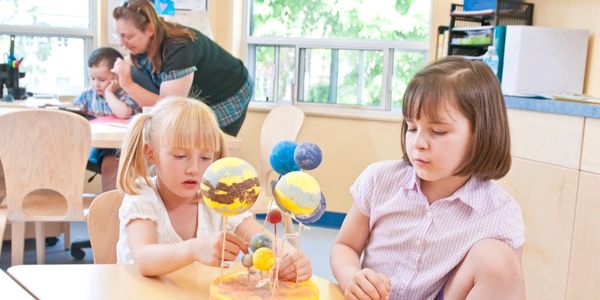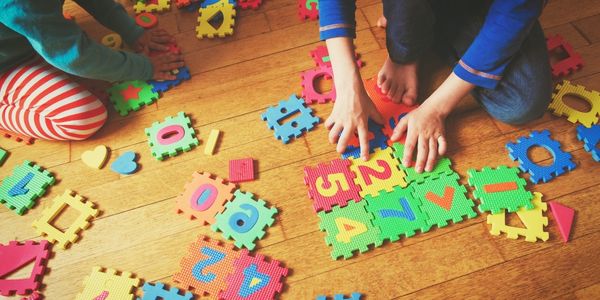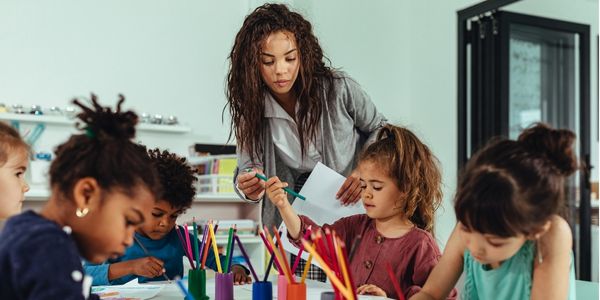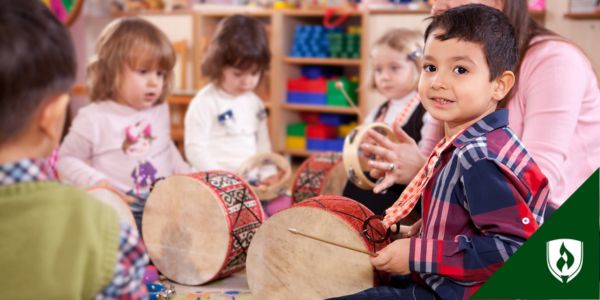What Is Inclusive Education? An Introduction for Early Childhood Educators
By Ashley Brooks on 04/12/2021

Parents and teachers know that no two children learn the exact same way. Naturally, developing children will have different preferences for engaging with their learning. However, children with special needs may require additional, differing levels of support within the classroom.
With so many needs and learning styles to manage, how can early childhood education (ECE) professionals meet the needs of all the children in their classrooms so that every child receives the education they deserve? Inclusive education is one solution to this dilemma.
What is inclusive education? Put simply, it’s the practice of providing high-quality education to students with special needs or disabilities within the same classroom settings as their peers.
Inclusive education sounds like a great idea, but it’s not always easy to bring this educational ideal to life. We researched ECE best practices to bring you this deep dive on inclusive education.
What is inclusive education?
A joint position statement by the National Association for the Education of Young Children (NAEYC)® and the Division for Early Childhood (DEC) defines inclusive education as “the values, policies and practices that support the right of every infant and young child[,] ... regardless of ability, to participate in a broad range of activities and contexts as full members of families, communities and society.”1
That sounds like a mouthful, but all it really means is that children of all abilities have the right to be fully included in a regular classroom, not shunted to the side because their developments or abilities aren’t the same as their peers.
Dr. Jen Newton, cofounder of Teaching Is Intellectual, puts it this way: “Inclusive education, in the truest sense, is all children experiencing belonging and community in a typical early childhood setting.”
Inclusive education stands in contrast to special education programs of the past, in which students left their regular classrooms—sometimes for most, if not all, of the school day—to attend class in a separate environment. Legislation in the Individuals with Disabilities Education Act (IDEA) and the Americans with Disabilities Act (ADA) changed this practice and “protects children’s rights to attend school alongside their peers without disabilities,” according to NAEYC.2
In an inclusive classroom, students with special needs receive an Individual Education Plan (IEP) tailored to their unique learning goals. Teachers, parents and other specialists can then work together to ensure that the students’ IEP requirements are being met from within the classroom. Although some students may still leave the classroom for certain therapies or one-on-one tutoring, it is for much less time than what was typical in years past.
The benefits of inclusive education
The NAEYC/DEC position statement doesn’t stop at defining inclusive education. It also presents the goals of this educational practice. When inclusive education is successful, both typically developing children and those with disabilities experience positive results, like a strong sense of belonging, connected relationships and development to reach their full potentials.1
“All children—and adults—benefit from inclusive learning opportunities,” Newton says. “In inclusive classrooms, we see an increase in empathy, in friendships, in differentiated instruction and in the development of a positive sense of self.”
Attending an inclusive classroom can be children’s first introduction to people who are different from them, which teaches children to value those who aren’t like them and to stop the spread of ableist biases.
The benefits of inclusive education become even clearer when you look specifically at children who have special needs. The Indiana Inclusion Study found that students with disabilities who spend high amounts of time in an inclusive classroom score better in both reading and math than those who are placed in separate special education classrooms.3
What inclusive education looks like in the classroom
Teachers have several strategies available to help them create an inclusive environment:
- Following the Universal Design for Learning (UDL) framework. These scientifically based guidelines were created to optimize teaching to the ways humans learn best.
- Providing multisensory learning opportunities. Young children of all abilities are wired to learn best when they’re actively interacting with materials. Rather than printing worksheets or expecting all students to sit still during lessons, create activities that allow children to have a more hands-on experience incorporating as many senses as possible.
- Offering adaptations for activities so that children of all abilities can fully participate in games, crafts and lessons.
- Creating different learning opportunities to teach the same concept so that children who learn in different ways will be able to absorb new ideas.
In the end, the two most important steps teachers can take to promote an inclusive classroom involve mindset. “The two biggest strategies are to presume competence in all learners and hold high expectations for all children in an inclusive setting,” Newton says.
Teachers who approach all students with respect for their abilities and the desire to help them reach their potentials are already well on their way to promoting inclusive education.
The fight to establish inclusive education
Despite the clear benefits to inclusive education, this practice isn’t always the norm in the U.S. education system. “Only about one-third of children ages zero to five are in inclusive settings full time,” Newton says. “Because of early childhood funding models, children with disabilities are often accessing early childhood environments without nondisabled peers.”
In a nutshell, this means that school districts’ funding and budget operations often lag behind the research and are still providing for children to receive special education the old-fashioned way, rather than progressing to the more successful inclusive education model.
ECE professionals are uniquely positioned to advocate for their students. Where parents may not know about inclusive education options or be unsure about whom to contact in their school district, teachers can take the first step by talking to directors or administrators about the evidence-based benefits of inclusive education.
The NAEYC/DEC position statement advises teachers to start by defining their program’s inclusion philosophy so that all teachers and staff are on the same page about inclusive education.1 From there, they can work with program leaders to revise their inclusivity standards, advocate for change within their school system and potentially even hold state and federal leaders accountable for making inclusive education a reality for children across the country.
Making the classroom a learning environment for every child
What is inclusive education? It’s an approach to teaching that views children of all abilities as worthy of a high-quality education.
If you’re feeling the pull toward the ECE field, you could be one of the next teachers to advocate for and provide inclusive education. But first, you’ll want to have the right education and training yourself. Learn more with our articles “What Can I Do with an Early Childhood Education Degree?” and "Teacher Assistant Duties"
1 NAEYC and DEC, joint position statement, “Early Childhood Inclusion,” [accessed March, 2021] https://www.naeyc.org/sites/default/files/globally-shared/downloads/PDFs/resources/position-statements/DEC_NAEYC_EC_updatedKS.pdf
2 NAEYC, “The Power of Inclusion: What to Expect When Your Preschooler Attends an Inclusive Preschool Program,” [March, 2021] https://www.naeyc.org/our-work/families/inclusion-preschool-program
3 Indiana University, “A Longitudinal Study to Determine the Impact of Inclusion on Student Academic Outcomes,” [accessed March, 2021] https://www.iidc.indiana.edu/cell/what-we-do/pdf/Inclusion-study-handout.pdf
NAEYC is a registered trademark of the National Association for the Education of Young Children.
The Early Childhood Education programs at Rasmussen University are not accredited by the NAEYC Commission on Early Childhood Associate Degree Accreditation. Rasmussen University is not a partner of NAEYC and our programs are not sponsored or endorsed by NAEYC.
Graduates of Early Childhood Education programs at Rasmussen University are not eligible for licensure as a teacher in an elementary or secondary school. A Bachelor’s degree and a state teaching license are typically required to work as a teacher in a public school and some private school settings. States, municipalities, districts or individual schools may have more stringent licensing requirements. Students must determine the licensure requirements in the state and school in which they intend to work.
Childcare facilities and the states in which they are located establish qualifications for staff who work with children and often implement guidelines regarding age, education, experience and professional development. Students must determine the licensure requirements for the state and facilities in which they work.
This program has not been approved by any state professional licensing body, and this program is not intended to lead to any state-issued professional license. For further information on professional licensing requirements, please contact the appropriate board or agency in your state of residence.




